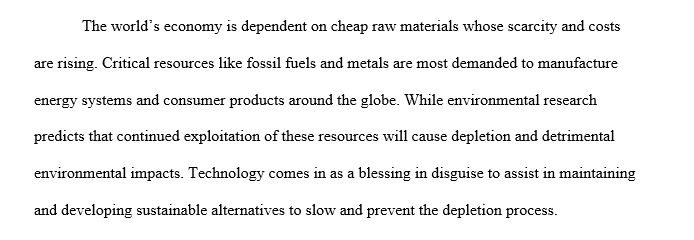Environmental science
This week you were introduced to environmental science. With some of your background knowledge, and what you have learned from your readings, consider the following statement:
The world will never run out of resources because we can use technology to find substitutes; this will help us reduce resource waste.
Do you agree with this statement? Explain your position.
To begin your exploration of the Environmental Problems, please visit the National Library for the Environment (NLE)(http://www.thecre.com/
Environmental science is an interdisciplinary study of how the earth works, how we interact with the earth, and how we deal with environmental problems. One of the most profound, prophetic, inspirational statements made on the environment was a speech given to President Franklin Pierce by “Chief Seattle” in 1854. President Franklin made an offer for two million acres of Indian Land and promised a Reservation for the Indian people. The text of Chief Seattle’s speech is his reply to President Pierce’s offer. Visit the following link to read the text of his speech http://www.halcyon.com/
Much controversy surrounds the authenticity of Chief Seattle’s speech. Some feel the speech was actually written by Ted Perry, who wrote a biography of Chief Seattle. Various versions of the speech exist. Each translation loses or embellishes parts of his message. The Ted Perry text of the speech was used for a film on pollution and ecology called “Home”. Film producers used the script without his knowledge, removed his name, and made posters with the speech. This began the confusion that exists today. Perry is pleased that his words have served as a powerful inspiration to many. The Chief Seattle Speech has a message to teach all of us about the environment. Would Chief Seattle agree or disagree with the spirit of the message?
World populations are putting pressure on the earth’s resources to meet our wants and needs. We classify these material resources as perpetual renewable or nonrenewable. In 1968, biologist Garrett Harden called the degradation of renewable resources the Tragedy of the Commons (http://science.
Supplying each person with renewable resources, and absorbing wastes from such resource use, creates a large ecological footprint or environmental impact. It measures the average environmental impact of individuals in different countries and areas.
Most of the harmful environmental problems we face in the world are the unintended results of human activities designed to increase the quality of life. Underlying causes of environmental problems include:
Rapid population growth
Poverty
Excessive and wasteful resources
Not including environmental costs in market prices
Inadequate understanding of how the earth works.
Matter is defined as anything that has mass and occupies space. The building blocks of matter are atoms, ions, and molecules. Atoms are made up of a nucleus containing protons and neutrons which are surrounded by a cloud of varying numbers of electrons. Compounds may be organic or inorganic (natural or synthetic). All organic compounds have a backbone made of carbon atoms. Inorganic compounds such as water, carbon dioxide, and table salt, are not based upon carbon atoms bonded together. The following website explains these concepts in detail: Matter: Atoms, Molecules, and States of Matter (http://www.
Matter can undergo chemical and physical changes. The Law of Conservation of Matter limits such changes. It states that there is no “away” in “throw away”. The Law of Conservation of Energy states that we cannot get something for nothing in terms of energy quantity. The second Law of Thermodynamics describes that in terms of energy conversion we always end up with less energy than we start with.
Solution preview for the order on environmental science
APA
329 words
